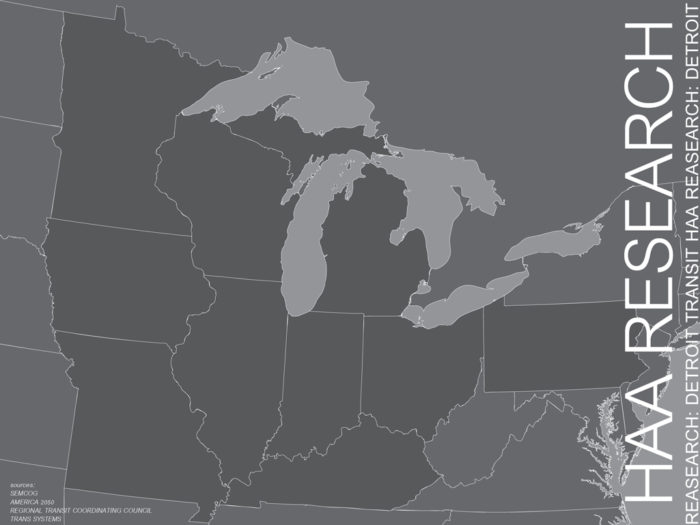Detroit Transit, Part 1
 Whither goest thou, America, in thy shiny car in the night? – Jack Kerouac
Whither goest thou, America, in thy shiny car in the night? – Jack Kerouac
Detroit is ironically the most and least likely place to discuss mass transit. Once the home of one of the nation’s most extensive streetcar systems, Detroit has become synonymous with decentralization, suburban expansion, and the dominance of the automobile. Where human mobility was once limited by the location of rail lines, canals, and the limited travel range of other non-motorized forms of transportation, the car provided a universal form of personal transportation which could be used at virtually any geographic scale. Unfortunately, the success of the car came at the expense of all other modes of transportation, eventually leading Detroit and other cities toward an inefficient and unsustainable transit monoculture.
Recently, infrastructural failures in this country have gained national and international attention. With increasing national imperative, as well as efforts at the regional and local level, it appears mass transit is finally becoming a reality. High-speed rail development in Florida between Tampa, Orlando and Miami, and in California linking Sacramento, San Francisco and L.A., has been covered extensively throughout the media. Portland Oregon’s streetcar system has become a benchmark for urban transit in this country. And the American Recovery and Reinvestment Act (ARRA) has allocated substantial funds to the development of public transit systems, indicating a shift in support and investment toward sustainable car alternatives. As this transition occurs, however, it is important to consider not only the new forms of transportation infrastructure and technology that will be necessary, but also the relationship between these and existing development patterns.
In his book, The Transit Metropolis (1998), Robert Cervero writes that in order for an urban mass transit system to work, both the transit systems and urban development strategies must be adaptive, synchronized, and complementary. In cities with predominantly low density development, like Detroit, proposed multi-modal public transit must address the realities of a dispersed population while also defining a vision for future transit oriented development. Rather than attempting to adapt new transportation technology to inefficient urban models, there needs to be a more pliable relationship between the two, allowing both to evolve under the influence of one another. To this end, it is important for the technologies employed to be flexible in how they interface with the urban environment, and should do so at multiple scales.
In Detroit, streetcar service ended in 1953. Since that time, a number of plans for city and metropolitan transit systems have been proposed. In 1969, The Detroit Regional Transportation and Land Use Study recommended a system of rapid transit for eight major corridors, but this plan was never realized. In 1976 President Gerald Ford offered $600 million for regional transit development, but the plan lacked political support and ultimately fell through. However, the recently constructed Rosa Parks Transit Center , the forthcoming Woodward Avenue Light Rail project, and the recently aired PBS documentary “Blueprint America: Beyond the Motor City”, are all signs that the city has embraced the potential of new public transportation.
The Detroit Regional Mass Transit Service Plan, which was approved in December of 2008, provides a phased plan for the development of rapid bus, light rail, and commuter rail transit lines. While this plan will certainly improve access to mass transit options, it is important that these become part of an urban strategy which addresses both the larger context of the region as well as the local specificities of a mixed-density city. The development of a comprehensive plan for Detroit marks the opportunity to fundamentally shift not only the way people move in the city, but how the city itself will continue to evolve in the coming years. If the last evolution in American transit history was marked by the ubiquity of the automobile, the next will be marked by the variety and flexibility of a multi-modal, and multi-scalar, public network.
As part of the ongoing HAA_Research effort, we will be exploring issues surrounding public transit both locally and nationally, in a series of subsequent posts. The topic is often painted with broad strokes which neglect its inherent intricacies. It is our hope that this installment approach will allow us to focus on specific areas of discourse within the broader debate and unfold the complexities therein. We look forward to the work growing and evolving through collaborative dialogue as transit once again takes hold in the Motor City.




